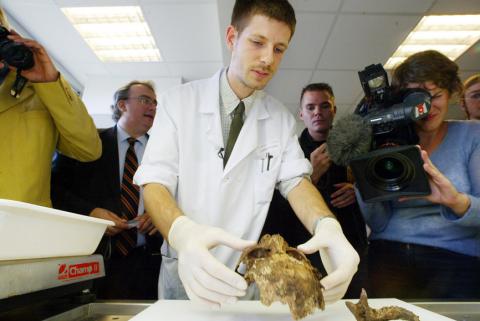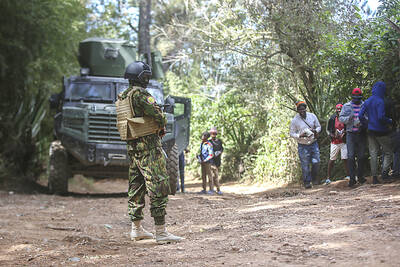The French media like to call him the “Indiana Jones of the graveyards,” but perhaps a better tag would be the Sherlock Holmes of forensic science.
With powerful microscopes and high-tech diagnostics that tease out chemical signatures and DNA telltales, pathologist Philippe Charlier pores over centuries-old remains to probe the riddles of history.
He has determined that Vatican-authenticated bone fragments said to have come from Joan of Arc were in fact from a cat and an Egyptian mummy.

Photo: AFP
He has confirmed that a mummified heart came from the uncrowned boy French king Louis XVII. He has crushed the folklore that said Napoleon was poisoned to death by his perfidious English captors.
Then in Diane de Poitiers, the mistress of King Henri II of France, Charlier made the shocking discovery that the 66-year-old had drunk an elixir of gold in what was apparently a desperate bid to keep her youth.
Now the scientist has turned his attentions to Richard the Lionheart, hoping to use what is left of his famous ticker to learn more about the legendary 12th-century English monarch.
Speaking at an exhibition on his work, Charlier referred to his ancient subjects as “patients,” for which a forensic scientist gradually develops a doctor-like relationship.
“One does tend to get attached,” he said.
Charlier used 3D imaging of a preserved skull to bring to life the face of French King Charles VII’s lover Agnes Sorel, the first woman in French history to hold the title of official mistress.
She died at the age of 28 in 1450, but her death mask belied the pixie-like beauty for which she was famed in life.
“Looking at it realistically, it’s ugly,” Charlier said of the mask, with its bulging forehead, small cheekbones and scrunched-up nose.
The scientist’s analysis determined that Sorel had died of mercury poisoning, an important ingredient of medical salts of the era.
Charlier’s laboratory is at the Raymond Poincare University Hospital in Garches, south of Paris.
In 2010, it confirmed that a severed head long thought to belong to Henry IV, murdered in 1610 by a Catholic fanatic, was indeed his — a finding that is disputed by some. Henry’s remains had been taken, along with those of other French nobles, from their tombs in the royal chapel at Saint-Denis in 1793 by revolutionaries, who tossed the remains into a pit.
The scientist is now examining a small sample of the heart of Richard I, who ruled England from 1189 to his death in 1199, apparently from blood poisoning after he was shot with an arrow.
Housed in the Gothic cathedral of Rouen, northern France, the relic comprises just a sprinkling of decomposed dust.
Charlier has taken “1mg or 2mg” of the precious remains and is carrying out chemical tests on them. The results are likely to be unveiled in the next three months, according to the French press.
The goal is to find out more about 12th-century embalming — the practice was carried out by barbers or even cooks — and perhaps identify the germ that killed the warrior-king.
“We know virtually nothing about the [embalming] techniques of that time,” Charlier told the Parisien daily. “It is a forensic challenge. We want to get the maximum information from the smallest possible sample.”
Richard is often described in textbooks as a pious leader, brave soldier and a dashing man of letters, but historians say this version masks a life of brutality, bloodshed and religious intolerance.
He led the Third Crusade of the Christian world against Muslims who had captured Jerusalem in the 12th century. He died at the age of 42 after being shot with a crossbow during a siege of the castle of Chalus-Chabrol in France.

DITCH TACTICS: Kenyan officers were on their way to rescue Haitian police stuck in a ditch suspected to have been deliberately dug by Haitian gang members A Kenyan policeman deployed in Haiti has gone missing after violent gangs attacked a group of officers on a rescue mission, a UN-backed multinational security mission said in a statement yesterday. The Kenyan officers on Tuesday were on their way to rescue Haitian police stuck in a ditch “suspected to have been deliberately dug by gangs,” the statement said, adding that “specialized teams have been deployed” to search for the missing officer. Local media outlets in Haiti reported that the officer had been killed and videos of a lifeless man clothed in Kenyan uniform were shared on social media. Gang violence has left

US Vice President J.D. Vance on Friday accused Denmark of not having done enough to protect Greenland, when he visited the strategically placed and resource-rich Danish territory coveted by US President Donald Trump. Vance made his comment during a trip to the Pituffik Space Base in northwestern Greenland, a visit viewed by Copenhagen and Nuuk as a provocation. “Our message to Denmark is very simple: You have not done a good job by the people of Greenland,” Vance told a news conference. “You have under-invested in the people of Greenland, and you have under-invested in the security architecture of this

Japan unveiled a plan on Thursday to evacuate around 120,000 residents and tourists from its southern islets near Taiwan within six days in the event of an “emergency”. The plan was put together as “the security situation surrounding our nation grows severe” and with an “emergency” in mind, the government’s crisis management office said. Exactly what that emergency might be was left unspecified in the plan but it envisages the evacuation of around 120,000 people in five Japanese islets close to Taiwan. China claims Taiwan as part of its territory and has stepped up military pressure in recent years, including

UNREST: The authorities in Turkey arrested 13 Turkish journalists in five days, deported a BBC correspondent and on Thursday arrested a reporter from Sweden Waving flags and chanting slogans, many hundreds of thousands of anti-government demonstrators on Saturday rallied in Istanbul, Turkey, in defence of democracy after the arrest of Istanbul Mayor Ekrem Imamoglu which sparked Turkey’s worst street unrest in more than a decade. Under a cloudless blue sky, vast crowds gathered in Maltepe on the Asian side of Turkey’s biggest city on the eve of the Eid al-Fitr celebration which started yesterday, marking the end of Ramadan. Ozgur Ozel, chairman of the main opposition Republican People’s Party (CHP), which organized the rally, said there were 2.2 million people in the crowd, but